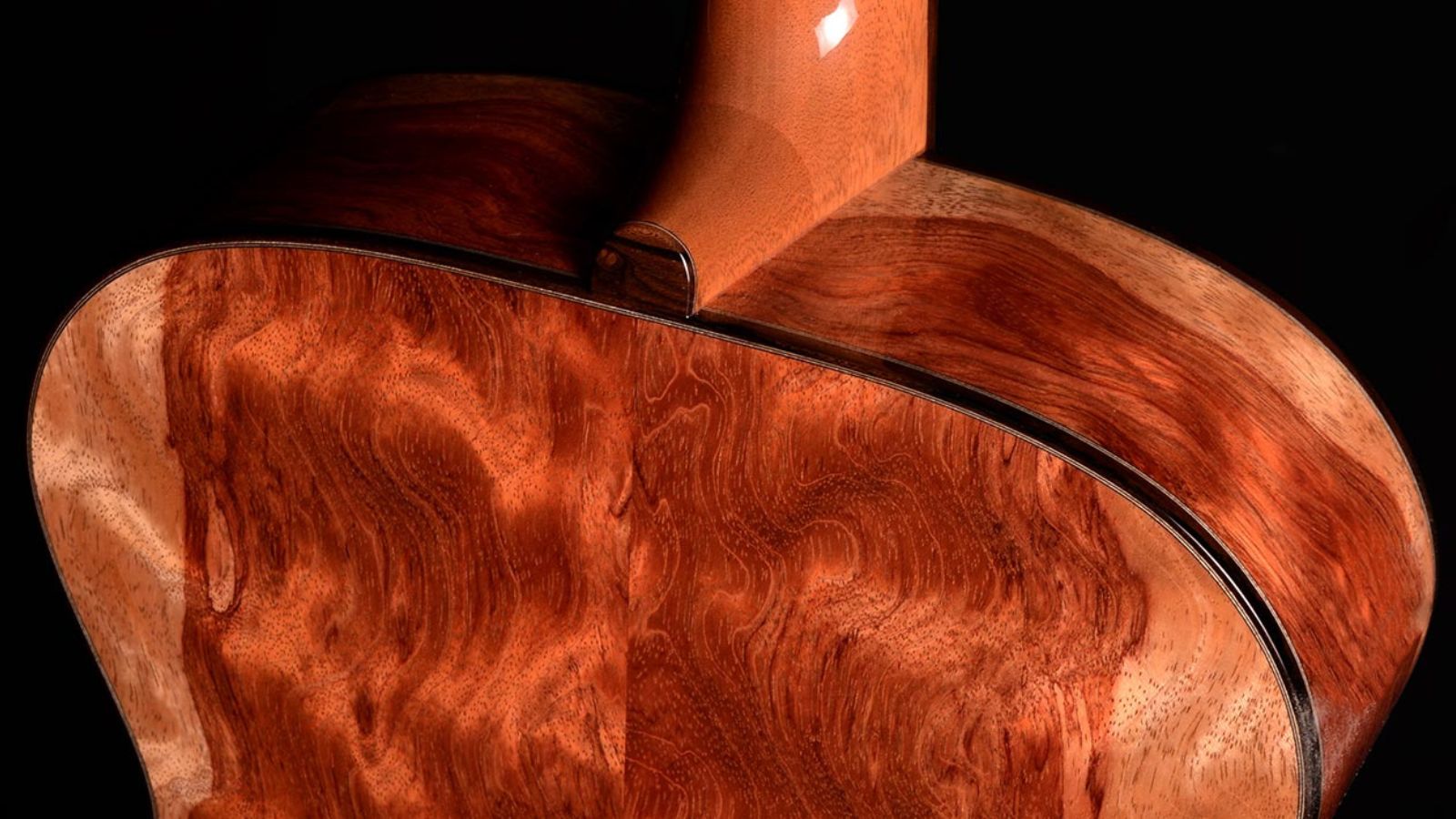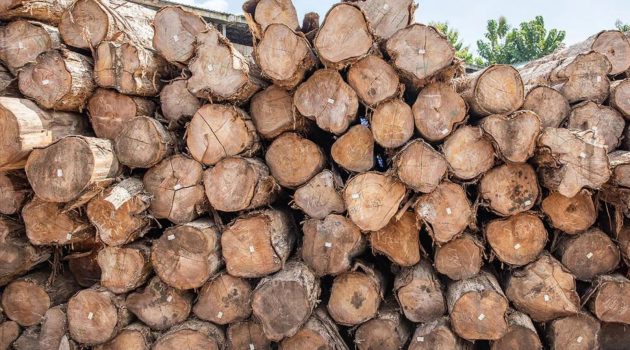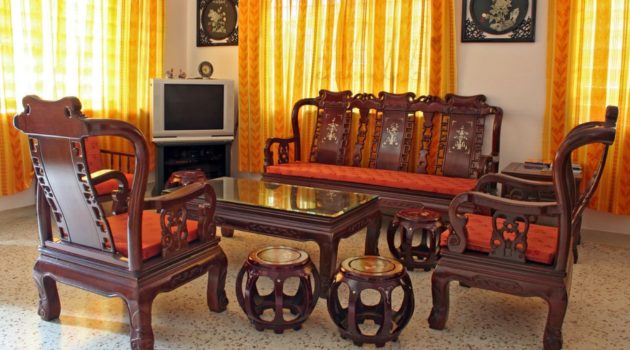Selecting the right tonewood for a guitar is critical for both its playability and the sound it produces.
Bubinga and cocobolo are two exotic woods that are often considered by enthusiasts and luthiers for their distinct auditory characteristics and striking aesthetics.
Bubinga, known for its tighter grain and brighter tone, shines with a push in the upper mids that is comparable to maple, yet offers softer highs and more mellow mids. Cocobolo, on the other hand, is a dense rosewood that yields a heavy guitar with clear and responsive tones, prized for its durability and rich color.
When comparing bubinga and cocobolo for guitar construction, several aspects must be considered, including their physical properties, tonal qualities, and the guitar maker’s intentions in sound and design.
While bubinga can contribute to a brighter, more pronounced midrange in a guitar’s sound profile, cocobolo provides warmth and complexity, making it a favorable option for those seeking a robust, resonant voice from their instrument.
Furthermore, the scarcity of these woods adds a layer of exclusivity and often prompts a discussion on responsible sourcing and environmental impact on the part of both manufacturers and players.
Key Takeaways
- Bubinga and cocobolo are exotic woods with unique tones, used for their sound and visual appeal in guitars.
- The choice of tonewood significantly affects the instrument’s sound, with bubinga offering a bright midrange and cocobolo a warm, complex tone.
- Ethical considerations are important when selecting rare woods like bubinga and cocobolo due to their scarcity and environmental impact.
1. Characteristics of Bubinga and Cocobolo
When selecting woods for your guitar, it’s important for you to understand the distinct characteristics of Bubinga and Cocobolo, as they affect both the instrument’s construction and sound.
These tonewoods offer unique physical properties and tonal qualities that cater to different playing styles and aesthetics.
Physical Properties
Bubinga:
- Density: Average dried weight of 56 lbs/ft³ (890 kg/m³)
- Hardness: Janka hardness of 2,410 lbf (10,720 N)
Cocobolo:
- Density: One of the densest woods, enhancing durability
- Hardness: Highly durable and strong, with a natural resistance to insects and weather
Tonal Qualities
Bubinga:
- Sustain: Due to its density and hardness, Bubinga provides good sustain.
- Tone: You can expect a rich tone with ample clarity and projection.
Cocobolo:
- Sustain: The high density of Cocobolo yields a bright tone with great sustain.
- Clarity: You’ll find excellent immediate response and pronounced clarity when played.
- Tone: Similar in some ways to rosewood species, yet Cocobolo often offers brighter and more sparkling overtones.
It’s worth noting that while both woods are strong and dense, making them suitable for guitar construction, their distinct tonal attributes are pivotal in shaping the instrument’s final sound.
2. Guitar Construction and Tonewood Selection
Choosing the right wood for your guitar can profoundly affect the instrument’s tone and aesthetics.
As a luthier or enthusiast looking to understand the intricacies of guitar construction, you’ll find that the selection between woods like bubinga and cocobolo is both a practical and artistic decision.
Impact on Sound
Bubinga and cocobolo are two exotic hardwoods often selected for their influence on a guitar’s resonance and sustain.
- Bubinga: Known for its rich, balanced tone and excellent sustain, it’s particularly favored in the construction of bass guitars and the bodies of electric guitars. Bubinga adds a warm and powerful middle range, often with a hint of brightness in the top end.
- Electric Guitar Construction: Often used in body and neck construction, providing a tight low end.
- Acoustic Guitar Construction: Less common for acoustic bodies due to its density but sometimes used for backs and sides.
- Cocobolo: Noted for its complexity and volume, cocobolo is often used for classical guitar construction. It accentuates the high and low frequencies, making it suitable for both the soundboard and fretboard.
- Durability: It stands up well to the tension requirements of classical guitar designs.
- Versatility: Lends itself well to both the body and neck construction, cocobolo is suited for acoustic and electric guitars alike.
Aesthetic Appeal
When it comes to beauty, both bubinga and cocobolo offer distinct visual characteristics that can take your guitar’s design to the next level.
- Bubinga: With its fine grains and range of colors from pink to reddish-brown, bubinga provides a visually unique and appealing option. It polishes to a high luster, enhancing the visual depth of the instrument.
- Often used for decorative tops on electric guitars or inlaid works due to its figuring.
- Cocobolo: It boasts striking grain patterns that can vary from yellow to dark red. This tonewood is notable for its density and fine pores which allow it to polish well.
- Popular for fretboards and headplates, cocobolo’s distinct aesthetics complement its sonic properties.
When selecting a tonewood for your next guitar, reflect on how these woods align with the desired sound and visual outcome you envision for your instrument.
Your preferences in weight, tone, and color will guide you to the ideal choice between these two remarkable tonewoods.
3. Environmental and Ethical Considerations
When you’re choosing between Bubinga and Cocobolo for your guitar, it’s important to consider how these woods are harvested and their impact on the environment.
Sustainable practice and ethical sourcing are crucial for the health of forests and the future of luthiery.
Harvesting and Sustainability
Bubinga, also known as Guibourtia demeusei, primarily comes from Central Africa.
Its harvesting is subject to regulations due to its listing under the Convention on International Trade in Endangered Species (CITES) Appendix II as of January 2, 2017. This requires documentation to ensure the legal and sustainable trade of the timber.
On the other hand, Cocobolo is a type of Dalbergia retusa, predominantly found in Central America.
Like Bubinga, Cocobolo is listed in the CITES Appendix II, which controls its trade. Sustainable harvest of Cocobolo is critical, as it not only maintains forest biodiversity but also benefits local communities.
Alternative Tonewoods
Builders and luthiers are turning to alternative tonewoods to reduce the reliance on exotic woods like Bubinga and Cocobolo. Here’s a brief list:
- Spruce Varieties: Options like Sitka, Engelmann, and Adirondack are often used for guitar tops due to their abundant supply and excellent tonal qualities.
- Ebony: Although also an exotic wood, it’s used more sustainably today with tighter controls and stewardship programs in place.
- East Asian Rosewood: While still exotic, some species may not yet be as critically impacted as others, but they still require careful consideration.
By making informed choices, you can support sustainable practices and contribute positively to global conservation efforts.



